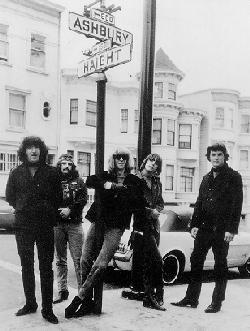THE SAN FRANCISCO SOUND: PSYCHEDELIC ROCK
In 1965, San Francisco suddenly became one of the most ebullient cities in the nation. The poets of the "Beat generation" moved here. Mario Savio founded the "Free Speech Movement" at the University of California at Berkeley.
The term "San Francisco Sound" refers to rock music performed live and recorded by San Francisco-based rock groups of the mid 1960s to early 1970s. Sometimes called psychedelic or acid rock, this form of rock was closely associated with the use of hallucinogenic drugs, such as Lysergic Acid Diethylamide (LSD); psychedelic art and light shows.
This music was, in many ways, the rock equivalent of abstract painting (Jackson Pollock), free jazz (Ornette Coleman) and beat poetry (Allen Ginsberg). These phenomena had in common a loose structure in which form "was" the content and an attitude of disregard for century-old aesthetic values. In music, this meant that improvisation was as important, and even more important, than composition.
 Psychedelia began in the folk scene, with the Holy Modal Rounders introducing the term in 1964. Perhaps the most representative group of musicians to come out of San Francisco during this period was the Grateful Dead featuring vocalist and lead guitarist Jerry Garcia. The Dead experimented with long, improvised stretches of music called jams. Psychedelia began in the folk scene, with the Holy Modal Rounders introducing the term in 1964. Perhaps the most representative group of musicians to come out of San Francisco during this period was the Grateful Dead featuring vocalist and lead guitarist Jerry Garcia. The Dead experimented with long, improvised stretches of music called jams.
Acid-rock musicians jammed in a slightly different context than jazz and blues musicians: they placed more emphasis on the melody, less emphasis on the virtuoso performance.
Musical influences came in from not only London and Liverpool, but also the bi-coastal American folk music revival of the 1950s and 1960s, the Chicago electric blues scene, the soul music scenes in Detroit, Memphis, and Muscle Shoals, jazz styles of various eras and regions, and more.
The lyrical content of the San Francisco Sound was both emotional and intelligent, reflecting the influence of such pioneering contemporary lyricists as Bob Dylan and John Lennon. Lyrics were deliberately, and often skillfully, poetic. In this respect for poetry, the San-Francisco-Sound writers were no doubt also influenced by the Beat Generation poets of the San Francisco Renaissance of a decade before.
Many bands formed, and each band had its characteristic sound, but enough commonalities existed that there was a regional identity. By 1966, fresh and adventurous improvisation during live performance was one characteristic of the San Francisco Sound. A louder, more prominent role for the electric bass was another feature.
Other prominent groups include the Beau Brummels, the Vejtables, Jefferson Airplane, Big Brother & the Holding Company, and Quicksilver Messenger Service. Despite the antiestablishment orientation of the youth culture at the time, a number of the musicians and groups that were prominent on the scene—including the Dead, Jefferson Airplane, Janis Joplin, and Santana eventually signed profitable contracts with major recording companies.
During the summer of 1967, the "alternative" became the "mainstream".
|

